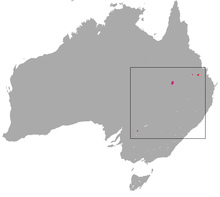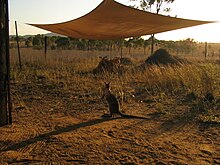Short-nailed kangaroo
| Short-nailed kangaroo | ||||||||||||
|---|---|---|---|---|---|---|---|---|---|---|---|---|

Short-nailed kangaroo ( Onychogalea fraenata ) |
||||||||||||
| Systematics | ||||||||||||
|
||||||||||||
| Scientific name | ||||||||||||
| Onychogalea fraenata | ||||||||||||
| ( Gould , 1841) |
The short-nailed kangaroo or rein-streaked nail kangaroo ( Onychogalea fraenata ) is a species of marsupial from the kangaroo family (Macropodidae).
features
Short-nailed kangaroos reach a head body length of 43 to 70 centimeters, plus the 36 to 73 centimeters long tail. Their weight is 4 to 9 kilograms, with the males becoming significantly larger and heavier than the females. As with most kangaroos, the rear legs are large and strong, but the front legs are significantly shorter. The tail is long and muscular, as with all nail kangaroos there is a small nail-like spur at the tip of the tail. The fur is predominantly gray on the upper side, the underside is whitish. The white, rein-shaped stripes that run from behind the ears over the neck and shoulders to the light underside are characteristic. In the hip area there are also white, but often inconspicuous stripes.
distribution and habitat
In the past, the short-nailed kangaroos were spread over large parts of eastern Australia , they lived in eastern Queensland , New South Wales and northern Victoria . Today the population is limited to three small areas in Queensland, such as Taunton National Park . Their habitat is rather dry, acacia-covered bush lands.
Way of life
These kangaroos are crepuscular or nocturnal. During the day they rest in tall grass or in low nests, at night they go in search of food. They live mostly solitary, and sometimes form groups when it is very dry. Their diet consists mainly of grasses and herbs, like all kangaroos they have a multi-chambered stomach in order to be able to better utilize the difficult to digest plant food.
The female gives birth to a single young animal after a gestation period of around 24 days. The newborns spend their first few months in their mother's pouch and become independent at around one year of age.
Danger
Short-nailed kangaroos were still relatively common until the end of the 19th century, when the population began to decline dramatically. The main cause of this was the conversion of their habitat into grazing areas for sheep . To a lesser extent, there was persecution by the introduced foxes and food competition with the rabbits . From 1937 to 1973 there were no sightings and the species was believed to be extinct. In the 1970s, a small population was discovered in an area of around 100 km² in Queensland. Parts of the area were bought by the government and a protected area, the Taunton National Park, was created. This area is the only one known today where the species still lives naturally. In addition, a breeding and reintroduction program was started. In two areas of Queensland, Idalia National Park and Avocet Nature Refuge, there are now wild populations again. In New South Wales, the animals were reintroduced to the Scotia Sanctuary.
The IUCN estimates the total population at less than 1,100 adult animals in the wild and lists the species as "critically endangered" ( endangered ).
In Europe, these kangaroos are no longer kept, former owners are Berlin, Frankfurt, Cologne and London.
supporting documents
literature
- Ronald M. Nowak: Mammals of the World . Johns Hopkins University Press, Baltimore 1999. ISBN 0-8018-5789-9
Web links
- Information at Animal Diversity Web
- Photos, videos and information at arkive.org
- Onychogalea fraenata onthe IUCN Red List of Threatened Species . Retrieved May 14, 2009.

